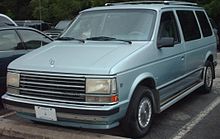Plymouth Voyager
For 1987, the model line was expanded with the extended-wheelbase Plymouth Grand Voyager and the luxury-trim Chrysler Town & Country for 1990.For the 1974 model year, Plymouth debuted light trucks under its own brand (for the first time since 1942), introducing the Voyager full-size van and the Trail Duster SUV.1978 brought major structural changes, as a redesigned B-pillar on long-wheelbase models saw the deletion of the filler panels between the front doors and side doors (on the driver side, one fewer window); On extended-length vans, the body was fitted with wraparound rear corner windows to improve rear visibility.[8] Also, the smaller vans were intended primarily to carry people, not cargo, so design and comfort were prioritized over payload.Beginning life as a modified version of the Dodge Omni, the new vans adopted a front-wheel drive layout.Following the project approval, the "T-115" small van program was funded through a large portion of the Chrysler federal loan guarantees.The model line was designed with a passenger-side sliding door (like a full-size van), but its front-wheel drive chassis allowed for a lower floor height (closer to a sedan/station wagon); the rear door used a one-piece liftgate, similar to a hatchback or smaller station wagons.First-generation Voyager minivans were offered in three trim levels: an unnamed base model, mid-grade SE, and high-end LE, the latter bearing simulated woodgrain paneling.Standard on all Voyagers were legally mandated side-impact reinforcements for all seating front and rear outboard positions.In 1985, on base and SE models, the front buckets could be replaced by a 40/60 split three-passenger bench seat, bringing the total number of occupants to six.The deluxe cloth upholstery was now standard on base and all SE models, with the luxury vinyl optional on SEs.Both a three-speed TorqueFlite automatic transmission and a five-speed manual were available with all inline-four engines, including the turbocharged 2.5 L (this was a rare combination).The LX which was available only on short-wheelbase Voyagers, was marketed as a sport-luxury minivan and came with the most standard equipment including alloy wheels, fog lamps, and a wide array of power-operated features.The "Sport Wagon" package available from 1993 until 1995 featured accent color (gray) bumpers and molding, fog lamps, and special aluminum wheels.This generation of vans brought additional innovations, including: The turbocharged engine and Convert-A-Bed feature were dropped.The previous K-car automobile platform and architecture were replaced with modern components and utilized Chrysler's cab-forward design.The third generation redesign was built on the new Chrysler NS platform and included a driver's-side sliding door, a minivan first.To reduce model overlap, the LE trim was discontinued in the United States (in favor of an expanded Town & Country range).Ergonomic levers at the seatbacks released the floor latches single-handedly without tools and raised the seats onto the rollers in a single motion.The 1996-2000 Dodge Grand Caravan (twin of the Voyager/Grand Voyager) received a "Marginal" rating in the Insurance Institute for Highway Safety's 40 mph offset test.Following the 2001 introduction of the RS-generation minivans, the Voyager was distinguished by a winged Chrysler emblem atop a black plastic grille (a shape adopted by the later PT Cruiser).After skipping the 2008-2020 fifth generation, the Voyager nameplate returned to use in North America for 2020 production, slotted below the Chrysler Pacifica and effectively replacing the Dodge Grand Caravan.










Chrysler minivansChrysler CorporationDaimlerChryslerMinivanFull-size vanChrysler/Lancia VoyagerPlymouthminivansDodge CaravanChrysler Town & CountryChrysler Voyager13th best-selling automotive model lineWindsor AssemblySaint Louis AssemblyPillette Road Truck AssemblySt. Louis North Assembly PlantDodge SportsmanDodge Ram WagonFenton, MissouriWindsor, OntarioBody styleLayoutFR layoutPlatformEngineTransmissionTorqueFliteTrail DusterDodge RamchargerFord CarouselVolkswagen MicrobusLee IacoccaDodge OmniRenault EspaceChevrolet Astro/GMC SafariFord AerostarTransverse front-engine, front-wheel driveChrysler S platformMitsubishimanualautomaticWheelbaseChrysler minivans (S)Car and DriverTen Best listairbagscup holdersDoug HenningTina TurnerCeline Dioninline-4carburetorsK-carshorsepower to weight ratioToyota VanVolkswagen Vanagonfuel-injectedMitsubishi G54Bautomatic transmissioninline-four enginesUltradriveUnited StatesCanadaall-wheel driveChrysler AS platformCurb weightChrysler minivan (AS)Chrysler K platformfog lampsmoldinganti-lock brakesairbagSt. Louis South Assembly PlantChrysler NS platformgasolineChrysler minivans (NS)cab-forwardMitsubishi 6G72sliding doorscargo netInsurance Institute for Highway SafetyPT CruiserChrysler PacificaDodge Grand Caravanarchive.todayvehiclesAcclaimBarracudaBelvedereBreezeCambridgeCaravelleColt VistaConcordConquestCranbrookCricketDe LuxeDusterGran FuryHorizonProwlerReliantRoad RunnerSapporoSatelliteSpecial De LuxeSuburbanSundanceSuperbirdTurismoValiantVolaréAdventurerTrucksArrow TruckPT-SeriesBackpackBelmontCabanaDuster IExplorerExpressoHowlerProntoPronto Spyder